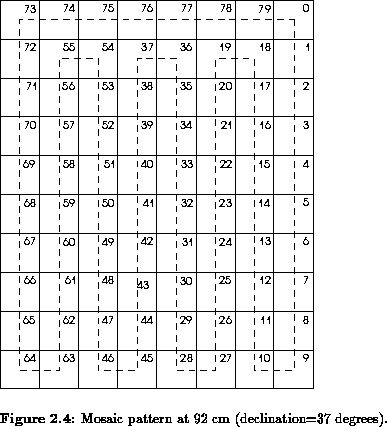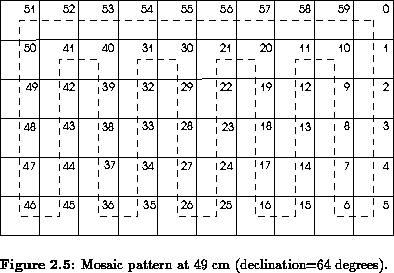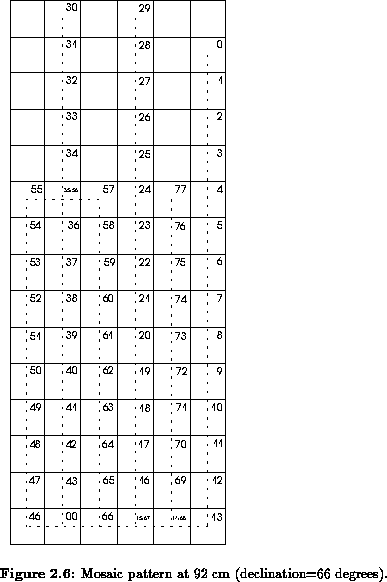(Parts of this section have been copied from the ASTRON NFRA Newsletter, December 1990). The standard procedure to observe with an interferometer is to lock the telescope onto one set of sky coordinates and track the observed object during observation. The result is a measurement of one field-of-view. A few attempts have been made to make observations with more than one pointing, which were reduced separately and linearly combined with proper weighting for the primary beam attenuation afterwards. However, the resulting sensitivity is non-uniform and the extra information that is available in the overlapping regions (due to the relatively close pointing distances, see below) isn't used during reduction as constraints on the sky brightness distribution.
Imaging an extended region requires fully sampling the area at pointing
distances less or equal than HWHM intervals, with the primary beam.
This ensures complete sampling of the visibilities in the (spatial frequency)
plane, with D/2 intervals in both coordinates. The regular east-west
array configuration of the WSRT, gives a radial sampling interval of nominally
72 m (this is declination and position angle dependent). By using six
different array configurations (moving the telescopes A, B, C and D) a radial
sampling of D/2 = 12 m can be obtained.
Together with the assumption that the data are subsequently used in parallel
to constrain the sky brightness, the sensitivity is guaranteed to be uniformal
within a few percent.
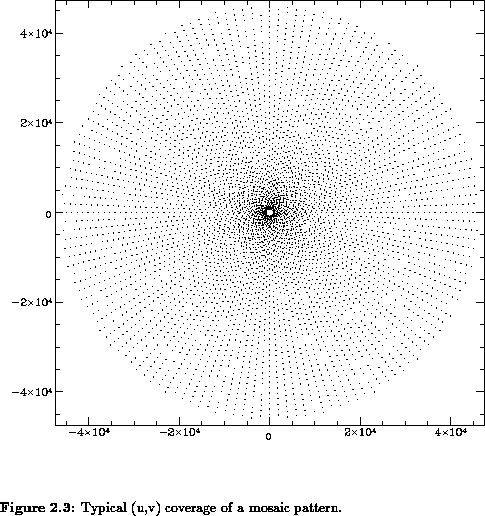
To keep the most complete coverage possible, an ideal mosaic observation should use rapid cycling through the different pointing centres, preferably sampling each before the earth rotation has significantly altered the projected baselines. In practice this is not possible, because the telescope can not move this fast and also the backend setup time is too large. The first tests that were carried out in 1989 showed that 40 seconds were typically lost for a requested move between pointing centres. Through careful optimization of the telescope slew and brake parameters, it has been possible to limit the move time between each pointing centre to 10 seconds. Within this time interval moves can be made between about 10 and 120 arcminutes. Faster speeds are not possible, but also not desirable because the on-line time unit of the WSRT is 10 seconds.
To reach a uniform sensitivity after correcting for the primary beam attenuation the grid interval between pointing centres has to be about one half of the primary beam halfpower width. At 92 cm this means a stepsize of 1.33 degrees and at 49 cm 0.7 degrees (the WSRT has got dishes with a 25 m diameter). Tables 2.2 and 2.3 give an overview of the different grid sizes and number of pointing centres, etc at both frequencies.
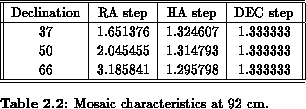
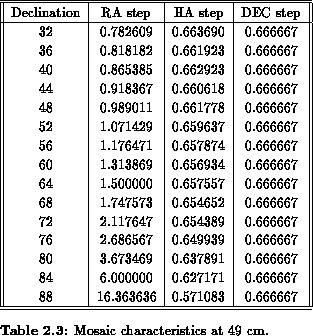
The efficiency of the telescope is not 100 %in mosaicing mode, because the system doesn't allow to take data while the telescopes are moving from one pointing centre to another. With an integration time of 20 or 30 seconds the efficiency becomes resp. 67 and 75 %. Each observation has its own number of pointing centres, depending on a variety of considerations. The most important qualifiers for a specific pattern are the frequency and the observed declination of the mosaic.
As an example, a few mosaic patterns of the WENSS survey are discussed below. A dutycycle of 40 minutes is used to cover one "round" in a mosaic pattern. This means that the pattern is scanned 18 times in a full 12 hour synthesis. This yields about 700 different UV points as well as 500 redundant UV points. At these relatively low frequencies (325 and 608 MHz) sidelobe confusion in the images becomes a very serious problem, because the large field of view intercepts a large number of sources. One way of dealing with this problem is to make the same observations at different array configurations (the 4 movable telescopes A, B, C and D are stepped at regular intervals). At 92 cm each mosaic is observed 6 times with 12 meter baseline increment. For the 49 cm observations only 3 different configurations with 24 meter baseline increment are used. The starting hour angles for a given pointing centre are phased such that a very regular UV coverage results. The total number of UV points becomes about 4000 at 325 MHz and about 2000 independent UV points are available at 608 HMZ. Immediately following the observations the data are sorted per pointing centre to permit efficient further off-line processing. Notice the special scan pattern in figure 2.4 which shows how the intervals between pointing centres changes due to the curvature in RA at high declinations.
